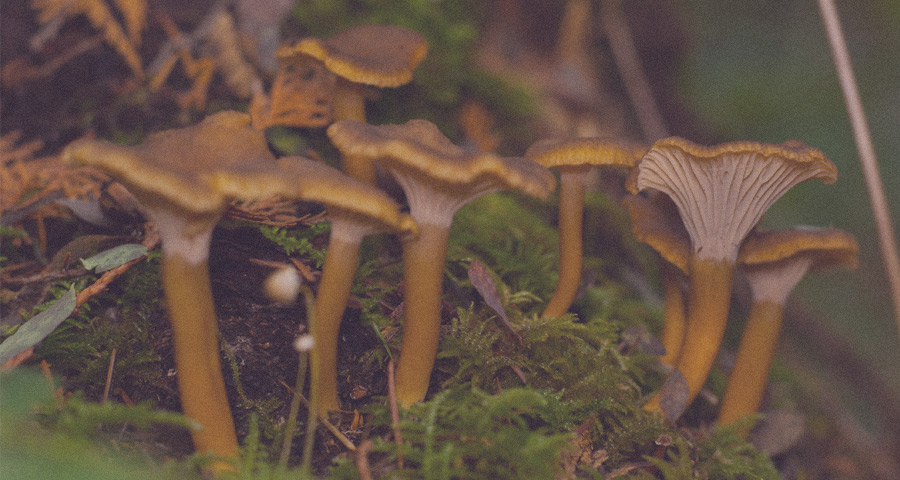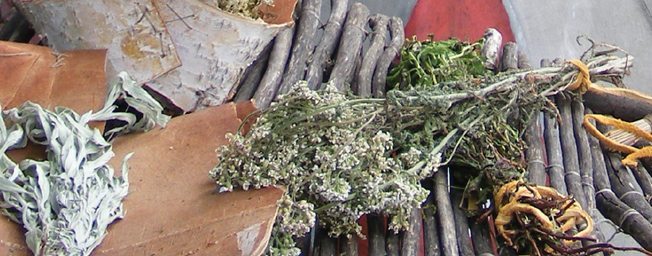
Winter Foraging Guide
Categories: Ecology & Sustainability Food & Nutrition
Though the fall harvest has come and gone, you can still find plenty of edible fruits, vegetables, and fungi, even in the winter months. No matter where you are, there are delicious foods for foraging. This weekend, get in touch with your primordial hunting and gathering instincts; I promise it’ll be a lot more fun than stalking a cantaloupe in the supermarket. As always, be sure to check and re-check as you sort through your spoils: while many plants are safe, many others are poisonous or could upset your stomach. Sergei Boutenko’s Wild Edibles and Robert Rogers’s The Fungal Pharmacy (from which the info below is adapted) are great references for beginning and continuing your foraging adventures, whether you’re looking for wild sources of nutrition, natural medicine, or yumminess.
Check back next week for recipes featuring your foraged plants: roasted veggies with burdock, a banandelion smoothie, dandelion and sun-dried tomato pesto, and cashew garden burgers with weeds. Happy hunting!
Burdock
[slideshow_deploy id=’38614′]
Burdock is a pretty versatile plant, since you can eat the leaves, stems, and roots. The roots are earthy, starchy, and a little bitter. The greens are mild. They’re available year-round, so they’re a huge asset to every forager.
To identify: Burdock leaves resemble rhubarb leaves. They’re dark green and oval, and have a distinct main vein. When mature (in their second year of growth), leaves can be more than two feet long. Young leaves emerging from the ground are covered with white, woolly fuzz. Flower heads are round and bur-like, with pink or purple flowers. Burs have Velcro-like hooks and easily attach themselves to clothing. These hooks are the best way to identify this plant.
Uses: Tender young leaves are delicious raw in salads or boiled as potherb. Roots are used in stir-fries and soups, or can be baked or fried.
Nutritional highlight: Burdock is incredibly nutritious. It’s an amazing detoxifier that has been used for centuries to help people cope with manmade pollution. Burdock also has anti-inflammatory properties that benefit a whole slew of conditions. It is also rich in folate, vitamins A, C, and K, plus calcium, magnesium, potassium, phosphorus, selenium, sodium, and zinc. Burdock has been used to purify blood and treat skin ailments such as eczema and psoriasis. Burdock is also beneficial for the liver and gallbladder.
Dandelion
[slideshow_deploy id=’38621′]
You can eat dandelion leaves, flowers, stems, and roots. The leaves, stems, and roots are bitter, but the flowers are sweet.
To identify: Dandelions typically have sharply serrated leaves, which grow in a basal rosette on the ground. Dandelions have one yellow flower per stem. As the flower matures, it turns into a white puffball. Stems are filled with milky, white sap. Dandelions have many lookalikes. Run your fingers along the main vein on the underside of a dandelion leaf. If it’s completely smooth, you’ve found a true dandelion. Dandelion lookalikes may have similar looking veins, but they will be hairy or prickly to the touch. Another great way to identify dandelions is by their flowers. Dandelions produce one flower per stem, while many imposters have two or more.
Uses: Greens can be used in salads or smoothies, or as trailside nibbles. Flowers can be eaten raw or prepared in a gourmet fashion. Roots are often dried, roasted, and ground as a coffee substitute. (Note that the roots require extra preparation.)
Nutritional Highlight: Rich in vitamins A, C, E, and K, and the minerals copper, phosphorus, potassium, iron, calcium, sodium, and magnesium. Dandelions are widely used to treat obstructions of the liver, kidneys, gallbladder, pancreas, and spleen. They have also been known to help diabetics reduce their blood sugar levels. Eating dandelions will also stimulate bile production and aid the digestive process.
There are more than 250 known species of dandelions (Wildflower Finder 2012). All species are edible and have no poisonous lookalikes. Dandelions are one of my favorite weeds, because of their many nutritional benefits and their widespread availability. If you are a novice forager, learning how to identify a dandelion will greatly expand your diet and guarantee free food everywhere you go. Picking young spring leaves will keep the bitterness to a minimum. This is true for most plants; the younger the green, the more nutritious and mild it will be.
Chaga
[slideshow_deploy id=’38627′]
To identify: Chaga or birch mushroom can be collected any time of the year from living trees, usually requiring an ax or saw. These black, porous growths have a sterile orange-brown area. They grow up to two kilograms or more and up to two meters in size. True chaga has a serrated edge on the underside, while false chaga is smooth.
Nutritional highlight: Chaga has been used as a counter-irritant in arthritis, liver disease, ulcers, and gastritis, among other conditions.
Uses: Chaga can be made into a variety of teas and soups.
Thistle
[slideshow_deploy id=’38644′]
To identify: There are many different types of thistles. All thistle varieties are edible. Plant is slender and upright. Leaves follow an alternate growth pattern and have sharp, woody thorns at the tips. Base leaves grow in a basal rosette and can look dandelion-like. Flowers can be white, yellow, pink, red, or purple. Thistles look like small artichokes. They have purple or yellow flowers surrounded by sharp thorns.
Uses: Peel rootstocks and enjoy raw as a trailside nibble. Use tender shoots and leaves in stir-fries, soups, teas, and vegetable roasts.
Nutritional Highlight: Thistles are widely used to treat obstructions of the liver, kidneys, gallbladder, pancreas, and spleen. They are also rich in vitamins A and C, plus copper, phosphorus, potassium, iron, calcium, and magnesium.
Helpful Tips: Sharp, hardy thorns can make harvesting thistles very unpleasant. It is a good idea to wear thick gloves when working with any thistle. I recommend using a knife to cut and peel the bottom three inches of the thistle stem. This section is tender, sweet, and juicy, and reminds me of a cucumber. Many thistles are considered invasive, so you can eat them without fear of over-harvesting. They have a high water content and help you replenish bodily fluids. If you’re hiking or foraging and, for whatever reason, have no other fluids available, thistles’ water-rich stems are a godsend.
Caution: Thistles have sharp spines. Please handle them with care. The tender leaves, shoots, stems, and roots are edible. Shoots and stems are tender and cool, like a cucumber.
Watercress
[slideshow_deploy id=’38651′]
Watercress leaves, stems, and flowers are edible and have a spicy flavor.
To identify: Watercress is a creeping aquatic plant often found near rivers and streams. Watercress likes to grow submerged or partially submerged in water. Leaves range from light to dark green and are round or oval in shape. Flowers are typically white and grow in clusters. It has round, lobed leaves that resemble arugula.
Uses: Eat raw in salads, wraps, and sandwiches. Watercress is spicy, like wild mustard, and is a great addition to recipes that require heat.
Nutritional Highlight: Watercress is high in protein content. It contains vitamins A, B1, B6, C, E, and K, plus folate, iodine, magnesium, calcium, potassium, selenium, and iron.
Helpful Tips: Because watercress grows in crowded thickets, it can be easily harvested with a pair of scissors. Simply grab a handful of watercress in one hand and use your other hand to cut it near the base.
Caution: Because watercress is a water-loving plant, take extra precautions to make sure that the water it grows in is not contaminated. Do not harvest watercress in areas where livestock are present. If you do, cook it to kill off potential parasites.
Black Trumpet
[slideshow_deploy id=’38665′]
Black trumpets are edible, with a buttery, woodsy flavor when fresh. When dried and reconstituted, it produces a rich, dark liquid.
To identify: It is smoky brown on top, with a brownish purple stem and, of course, a trumpet shape.
Uses: Dried, reconstituted black trumpets are perfect in fish sauces. It is good in egg dishes and may be best when simmered in cream. It goes well with white wine, seafood, chicken, veal, and pasta.
Nutritional Highlight: Dried black trumpets are more than 50 percent protein. Research also suggests that compounds in black trumpets can inhibit the growth of certain kinds of tumors.
Wild Onion
[slideshow_deploy id=’38655′]
The leaves, stems, flowers, and roots are edible.
To identify: Looks, smells, and tastes like an onion. Leaves may be tubular or flat. Flowers grow in clusters and range in color from white to pink to purple.
Uses: The entire plant is edible and can be used in the same way as a store-bought onion. It can be consumed raw or cooked, in salads, sandwiches, soups, stir-fries, and so forth.
Caution: Wild onions are part of the lily family, which contains many members. Some lily varieties are not fit for consumption. Wild onions are the only lily variety that have a distinct onion smell.
Pine (Douglas Fir)
[slideshow_deploy id=’38659′]
To identify: Coniferous evergreen tree with drooping branches. Bark is ridged with deep lesions. Needles are flat and short. Pinecones grow in clusters near the tips of the branches. Pinecones are scaly and delicate and display what looks like a tiny mouse-tail sticking out between the scales.
Uses: Steep green needles in boiling water and drink the wonderfully aromatic tea. Harvest light green, tender needles (found at the tips of the branches in the spring) and eat raw in salads or smoothies, or as a trailside nibble. Collect pollen from the flowers at the tips of branches in early spring and add to smoothies for a protein boost.
Nutritional Highlight: Rich in vitamins A and C. Fir needle tea helps fight dandruff when applied to the scalp. Resin found in evergreen needles is beneficial for respiratory problems. Consuming the greens raw or in a tea has been said to eliminate coughs, fevers, and excess mucus. Fir resin is great for removing sugars from teeth; the needles can be used as a makeshift toothbrush. Pollen is rich in protein. Fir tinctures have been used to fight inflammation and sore throat, as well as to treat skin infections.
Helpful Tips: Douglas fir trees have an inner bark (cambium layer) that is sweet and delicious. However, the improper harvesting of this layer can kill the whole tree. Instead of peeling away bark from the trunk of the tree, harvest individual branches for their inner bark. When the tree is blooming and the buds are full of pollen (in the spring), you can cover the tip of a branch with a plastic bag and give it a vigorous shake. Pollen will accumulate quickly in the bag. Transfer the collected pollen to a glass jar and store in a cool, dry place. Add as a supplement to smoothies. ID Trick: Identifying a fir tree can be tricky. After all, most evergreens look like Christmas trees. The easiest method I have found to tell common conifers apart is by their needles. All pines have long needles that grow in groups of two, three, or five. Fir and spruce trees have short needles all around the twig, so that the twigs resemble pipe cleaners. Fir needles are flat, while spruce needles are four-sided. If you are unsure whether you are looking at a fir or spruce, pick a few needles and roll them between your fingers. Since fir needles are flat, they will not roll easily. Douglas firs are extremely easy to identify by their cones. Douglas fir cones have little mouse-like tails that stick out between the scales of the cone.
Caution: Do not eat evergreens if you are pregnant, breast-feeding, or have seasonal allergies. For all other purposes, eating Douglas fir parts is absolutely safe. You can eat the inner bark, sap, twigs, catkins, light green tips, needles, cones, pollen, and nuts. Its flavor is slightly lemony, but the inner bark (cambium layer) is sweet.
Chanterelle
[slideshow_deploy id=’38668′]
They have a delicious and decidedly earthy smell and taste when dried, and taste wonderful when cooked.
To identify: The caps of this beautiful mushroom are spoon or fan shaped, rather than trumpet-like. It is found under spruce and fir in the Montane region of the Rocky Mountains and throughout North America.
Uses: Chanterelles can have an unpleasant taste (and upset your stomach) when eaten raw, so it’s best to cook them thoroughly or eat them dry.
**Disclaimer: Identification and use of wild plants requires particular care, expertise, and attention. Never eat any plant unless you are absolutely sure that it is edible. This post is for informational purposes only and North Atlantic Books assumes no liability based on the contents of this post or the books from which the information is sourced.
Tags: Robert Rogers Gardening Sergei Boutenko




